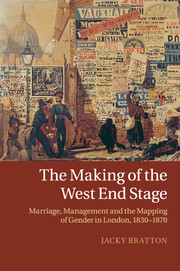 The Making of the West End Stage
The Making of the West End Stage Chapter 5 - The shaping of West End management
from Part II - Making
Published online by Cambridge University Press: 05 November 2011
Summary
The story of the Victorian entertainment world has not so far been told with women in an important managerial or empowered capacity at its centre. Kerry Powell's intention in his Women and the Victorian Theatre was to argue that ‘Victorian theatre conspired in producing repressive codes of gender even as it provided women with a rare opportunity to experience independence and power’, taking as his evidence for this the rhetoric of social control through masculine assertions of gender superiority that he found pervasively present in late Victorian theatrical writing. He is entirely justified, from that perspective, in his assertion that women's theatrical power is ‘a forgotten tradition’ buried by the defensiveness of men and their ‘pervasive rhetoric’ of the impossibility of women writing plays or managing playhouses. But his interest is chiefly in correcting the record of playwriting, at the end of the century, rather than in exploring the decades of female management and stage power that preceded it, and caused the ‘masculine panic’ that wrote them out of the record. In this chapter I intend to step back beyond the point at which the formation of that united male front blocked our view of the successful theatre women of the mid century.
I have already indicated the received history, which is that the theatrical managements of Macready, Charles Kean, Samuel Phelps, Benjamin Webster and Squire Bancroft are to be understood as the foundations of London's theatre in the 1840s, 1850s and 1860s – the piers of the bridge by which the gulf between the Romantic stage, on the one hand, and Ibsen and Henry Irving on the shores of Modernism, on the other, may be negotiated. That is the late-Victorian perception, readily accepted by subsequent writers and still influential in Powell's book, since he came to the issue via work on Oscar Wilde and the late Victorian popular stage, where misogyny is entrenched. But a fresh look at even the male commentators in the mid and early Victorian periods suggests a less embattled, more even-handed appreciation of the managerial achievements of women; and it is not difficult to tell another story, even about Bancroft, Kean, Webster and the other dominating male figures of the time, by reference to the copious evidence of the contemporary press. We need to remember that these dominant men were not by any means alone, and to attend to the wives and partners who worked with them; and, looking a little further, to discern that there were many more working managers, some of whom were female, making up the rest of the mid-century landscape. Numerically, and no doubt in terms of the wealth and publicity they generated, there were more men than women in charge of Arnold's ‘contemptible’ theatre (see Chapter 2) – more, but actually not overwhelmingly more. The appearance of female absence is misleading. Many successful women, managing, directing and organising as well as acting, have been discounted – their stories deliberately suppressed, according to Powell's account; and an examination of their contributions, rather than a focus upon the rhetoric of their suppression, might go some way towards a better account of the origins of the West End as it has developed.
Information
- Type
- Chapter
- Information
- The Making of the West End StageMarriage, Management and the Mapping of Gender in London, 1830–1870, pp. 145 - 169Publisher: Cambridge University PressPrint publication year: 2011